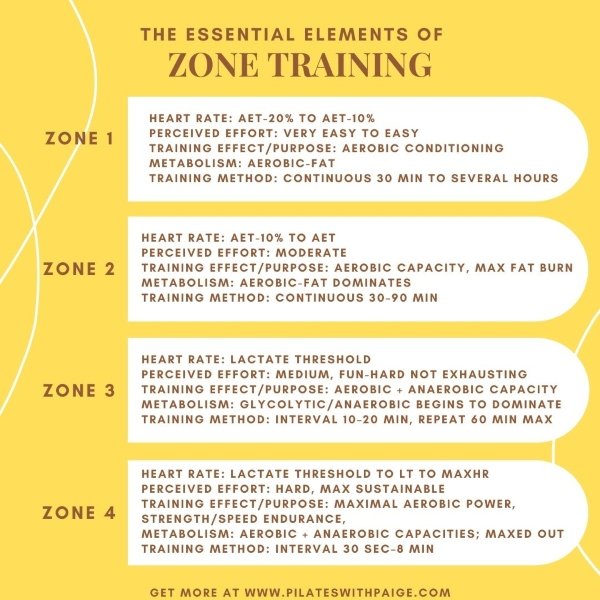As promised, here's the zone training I mentioned yesterday.
Now, zone training isn’t new, it outlines the needs + doses of movement needed to create a successful fitness routine that supports your body AND produces killer results. And like I mentioned yesterday, it changes for every age range.
Personally, I’ve followed this methodology to sustain my lean physique during my professional dancer career, to have the endurance + strength to climb Mount Whitney (a 2000 foot vertical rock climb) and post pregnancy, to assist my body in recovery after my adrenals crashed.
But like I mentioned before, the key here is using this based on where you are today…
Below I'm going to teach you how to find + calculate your ideal "zones".
Take your time with this chart. It’s a lot of “re learning” at first, but once you get the hang of it, results come effortlessly.
Notice how each zone addresses a different aspect of training…fat burning, recovery, overall conditioning, etc. All of these different zones need to be present in your program to get max results with minimum effort. But they don’t all need to be executed each day.
For example, if “Jane” is always doing chronic cardio in zone 3 because she’s trying to lose weight, her progress will be slow and she won’t achieve her desired outcome. For fat loss, she needs be doing the bulk of her fat burning cardio in zone 2 and without the strength components like Pilates or weight training, her body composition (the way her muscles develop) won’t be lean + dense.
Her result: She’ll be “skinny fat” and ALWAYS having to watch her calorie intake because she hasn’t built any muscle (muscle increases your metabolism so you can eat). Yay!
Obviously, the “zones” will vary depending on the health of your body today. Because if you’re recovering from adrenal fatigue your needs will differ from that of an Olympic weight lifter. Yet, the zone training DOES support them both.
Step #1
Identify your max heart rate.
The formula to do this is simply 220-(your age).
Step #2
Below, I’ve provided a “cheat sheet” for you to discover your appropriate zones (otherwise, it’s Math class time…hard pass!).Once you’ve identified your ranges in the second chart, match them to the zones in the first chart.
Ex: Jane is 35, her low intensity numbers are matched with zone 1. She would need to stay in the range of 92-110 for the duration of her workout to stay in "the zone".
The key to achieving your desired outcome is to know what you’re trying to achieve on any given day of your training. Your fitness, body composition, and healing goals require different types of training on different days.
Once you've defined your goals, all you need to do is make sure you keep within the appropriate "zone" when you're working out.
If your workout feels easier, trust that less output = greater results. If it feels harder, lean into it safely or backoff until your body says “yes!”
Now there's a lot more to applying zone training to your personal routine, but I want to keep this simple for you all to get started. If there's interest in this topic, I can elaborate...
So, find your zones, lean into trusting your body’s innate system + go from there.
Happy working out!
That’s it for today…if you’re feeling like you need more support or have questions, here's the link to speak with me 1:1. Space limited.


